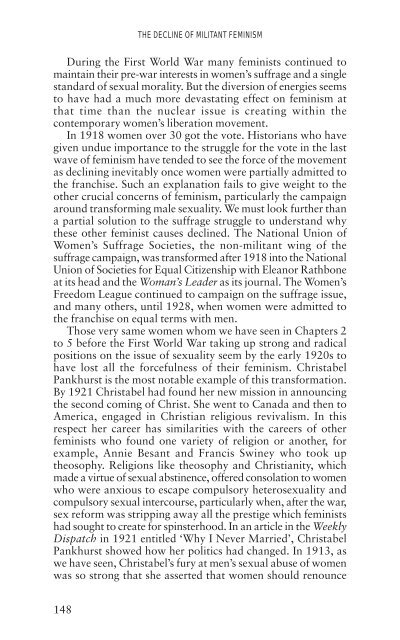The Spinster and Her Enemies - Feminish
The Spinster and Her Enemies - Feminish
The Spinster and Her Enemies - Feminish
You also want an ePaper? Increase the reach of your titles
YUMPU automatically turns print PDFs into web optimized ePapers that Google loves.
THE DECLINE OF MILITANT FEMINISM<br />
During the First World War many feminists continued to<br />
maintain their pre-war interests in women’s suffrage <strong>and</strong> a single<br />
st<strong>and</strong>ard of sexual morality. But the diversion of energies seems<br />
to have had a much more devastating effect on feminism at<br />
that time than the nuclear issue is creating within the<br />
contemporary women’s liberation movement.<br />
In 1918 women over 30 got the vote. Historians who have<br />
given undue importance to the struggle for the vote in the last<br />
wave of feminism have tended to see the force of the movement<br />
as declining inevitably once women were partially admitted to<br />
the franchise. Such an explanation fails to give weight to the<br />
other crucial concerns of feminism, particularly the campaign<br />
around transforming male sexuality. We must look further than<br />
a partial solution to the suffrage struggle to underst<strong>and</strong> why<br />
these other feminist causes declined. <strong>The</strong> National Union of<br />
Women’s Suffrage Societies, the non-militant wing of the<br />
suffrage campaign, was transformed after 1918 into the National<br />
Union of Societies for Equal Citizenship with Eleanor Rathbone<br />
at its head <strong>and</strong> the Woman’s Leader as its journal. <strong>The</strong> Women’s<br />
Freedom League continued to campaign on the suffrage issue,<br />
<strong>and</strong> many others, until 1928, when women were admitted to<br />
the franchise on equal terms with men.<br />
Those very same women whom we have seen in Chapters 2<br />
to 5 before the First World War taking up strong <strong>and</strong> radical<br />
positions on the issue of sexuality seem by the early 1920s to<br />
have lost all the forcefulness of their feminism. Christabel<br />
Pankhurst is the most notable example of this transformation.<br />
By 1921 Christabel had found her new mission in announcing<br />
the second coming of Christ. She went to Canada <strong>and</strong> then to<br />
America, engaged in Christian religious revivalism. In this<br />
respect her career has similarities with the careers of other<br />
feminists who found one variety of religion or another, for<br />
example, Annie Besant <strong>and</strong> Francis Swiney who took up<br />
theosophy. Religions like theosophy <strong>and</strong> Christianity, which<br />
made a virtue of sexual abstinence, offered consolation to women<br />
who were anxious to escape compulsory heterosexuality <strong>and</strong><br />
compulsory sexual intercourse, particularly when, after the war,<br />
sex reform was stripping away all the prestige which feminists<br />
had sought to create for spinsterhood. In an article in the Weekly<br />
Dispatch in 1921 entitled ‘Why I Never Married’, Christabel<br />
Pankhurst showed how her politics had changed. In 1913, as<br />
we have seen, Christabel’s fury at men’s sexual abuse of women<br />
was so strong that she asserted that women should renounce<br />
148

















